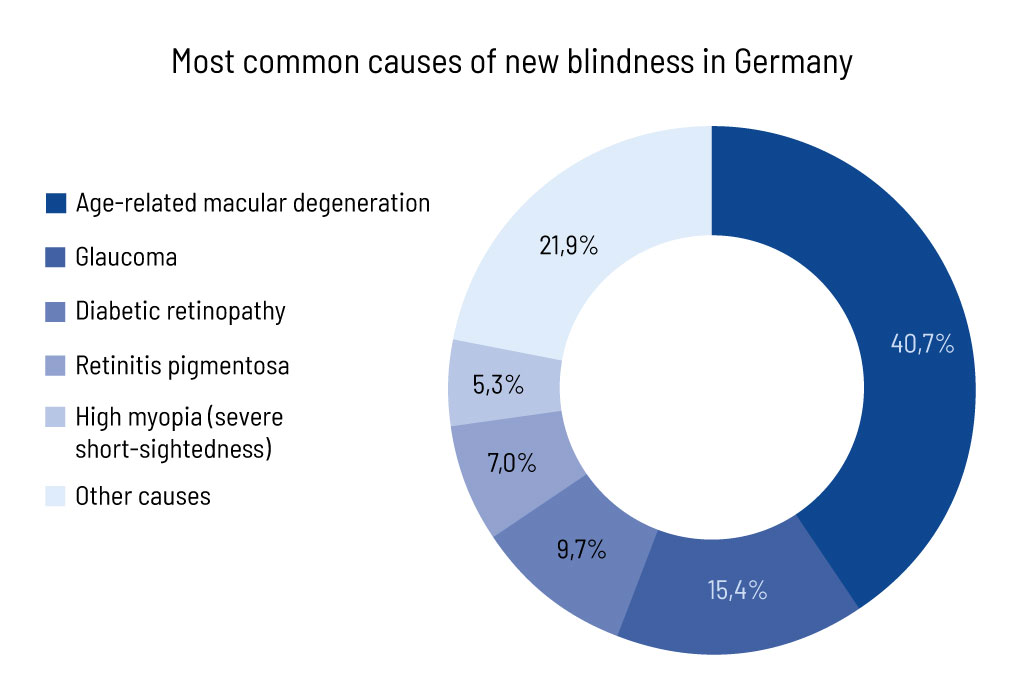Eye diseases can affect different regions of the eye and thereby evoke different disease patterns, that can lead to blindness (figure 1). This can be caused by a variety of factors, including genetics. Early diagnosis of an eye disease is important to improve treatment options and, if possible, to counteract the consequences of the disease in good time and prevent blindness. Determining the genetic risk can help with this.
Are you insured in Germany? Our colleagues at the Zentrum für Humangenetik Tübingen will gladly support you!
Figure 1: Proportion of the most common causes of blindness among new blindness cases (modified).1
How Are Our Eyes Structured and What Eye Diseases Are Tested For?
Our eyes process pictures from the environment by bundling the incident light in the retina and transmitting the information through the optic nerve to the brain. To do this, the light must pass through the cornea, the anterior chamber of the eye, the pupil, the lens, and the vitreous body to the retina.
The vitreous body consists of a clear, gel-like substance and gives the eye its shape. The so-called aqueous fluid inside the eye supplies it with nutrients and influences the intraocular pressure. The aqueous fluid is constantly being rebuilt. If it cannot drain properly, the intraocular pressure increases, and the optic nerve can be damaged, leading to blindness (figure 2). This is one of the causes of glaucoma. Risk factors include e.g. increased intraocular pressure, diabetes, chronic eye inflammation, and cardiovascular disease. Around 5% of glaucoma is based on inherited genetic changes, which can lead to the onset of the disease earlier in life.
Other hereditary eye diseases can affect the retina. These include, for example, retinitis pigmentosa and Stargardt’s disease. The retina is damaged in these diseases, leading to compromised function, which can cause severe visual impairment.
Depending on the specific disease, various treatment options can improve symptoms, slow down, or even stop the progression of a disease if it is detected early. For example, lowering intraocular pressure to prevent secondary damage in the case of glaucoma. For retinitis pigmentosa, for example, gene therapies can be considered.
Field Report
Nina B., 37 years old
Lifestyle: athletic, adventurous
Result: with our preventive diagnostics for Nina B., we identified an increased risk for glaucoma through a variant in the gene MYOC.
Consequence: Nina B. now has regular eye examinations. For example, her intraocular pressure and the back of her eye are examined in order to prevent visual field defects and maintain her vision.
“I have a genetic predisposition to glaucoma. That is why I now visit the ophthalmologist at regular intervals to have the condition of my eyes checked and, if necessary, to be able to intervene at an early stage.”
How Does Genetic Risk Assessment Work?
In the Eye Diseases module, NGS is used to investigate five genes that are responsible for the occurrence of eye diseases.
If an increased risk of an eye disease is detected with the Disease Prevention Panel, appropriate early detection programs can provide the opportunity for timely treatment in the event of the disease. In the case of glaucoma, for example, early detection of the disease due to a genetic predisposition can lead to a more favorable prognosis.
You Are also Welcome to Take a Look at the Following Areas
Contact Us
Do you have a question, or are you interested in our service?
Diagnostic Support
We will assist you in selecting the diagnostic strategy – whether as a person seeking advice or as a physician.

References
1 Finger, R. P., Bertram, B., Wolfram, C. & Holz, F. G. Blindness and visual impairment in Germany: a slight fall in prevalence. Deutsches Arzteblatt international 109, 484–489; 10.3238/arztebl.2012.0484 (2012).





